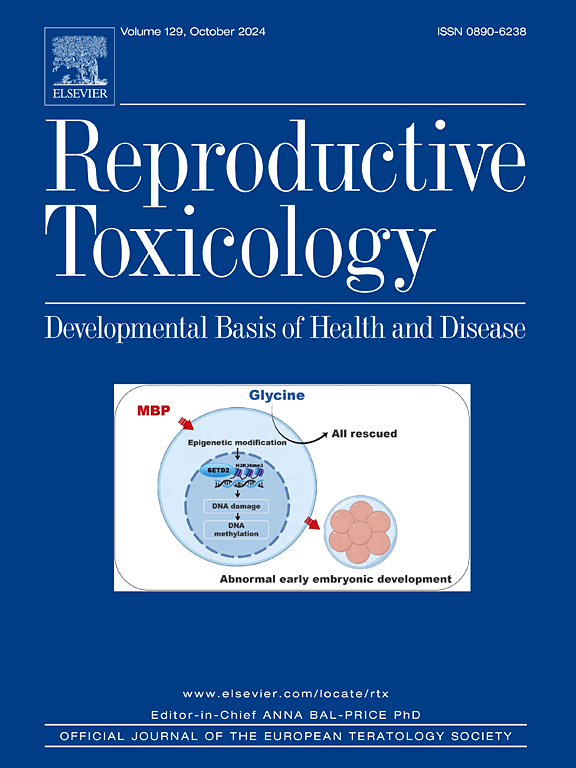The convergence of mTOR signaling and ethanol teratogenesis
IF 2.8
4区 医学
Q2 REPRODUCTIVE BIOLOGY
引用次数: 0
Abstract
Ethanol is one of the most common teratogens and causes of human developmental disabilities. Fetal alcohol spectrum disorders (FASD), which describes the wide range of deficits due to prenatal ethanol exposure, are estimated to affect between 1.1 % and 5.0 % of births in the United States. Ethanol dysregulates numerous cellular mechanisms such as programmed cell death (apoptosis), protein synthesis, autophagy, and various aspects of cell signaling, all of which contribute to FASD. The mechanistic target of rapamycin (mTOR) regulates these cellular mechanisms via sensing of nutrients like amino acids and glucose, DNA damage, and growth factor signaling. Despite an extensive literature on ethanol teratogenesis and mTOR signaling, there has been less attention paid to their interaction. Here, we discuss the impact of ethanol teratogenesis on mTORC1’s ability to coordinate growth factor and amino acid sensing with protein synthesis, autophagy, and apoptosis. Notably, the effect of ethanol exposure on mTOR signaling depends on the timing and dose of ethanol as well as the system studied. Overall, the overlap between the functions of mTORC1 and the phenotypes observed in FASD suggest a mechanistic interaction. However, more work is required to fully understand the impact of ethanol teratogenesis on mTOR signaling.
mTOR 信号转导与乙醇致畸的交汇。
乙醇是最常见的致畸剂之一,也是导致人类发育障碍的原因之一。据估计,在美国,1.1% 到 5.0% 的新生儿会患上胎儿酒精谱系障碍(FASD),它描述了因产前接触乙醇而导致的各种缺陷。乙醇会导致许多细胞机制失调,如细胞程序性死亡(凋亡)、蛋白质合成、自噬和细胞信号传导的各个方面,所有这些都是导致 FASD 的原因。雷帕霉素机制靶标(mTOR)通过感知氨基酸和葡萄糖等营养物质、DNA 损伤和生长因子信号来调节这些细胞机制。尽管有关乙醇致畸和 mTOR 信号转导的文献很多,但对它们之间相互作用的关注却较少。在这里,我们讨论了乙醇致畸对 mTORC1 协调生长因子和氨基酸感应与蛋白质合成、自噬和细胞凋亡的能力的影响。值得注意的是,乙醇暴露对 mTOR 信号转导的影响取决于乙醇的时间和剂量以及所研究的系统。总之,mTORC1 的功能与在 FASD 中观察到的表型之间的重叠表明两者之间存在机理上的相互作用。然而,要全面了解乙醇致畸对 mTOR 信号转导的影响,还需要做更多的工作。
本文章由计算机程序翻译,如有差异,请以英文原文为准。
求助全文
约1分钟内获得全文
求助全文
来源期刊

Reproductive toxicology
生物-毒理学
CiteScore
6.50
自引率
3.00%
发文量
131
审稿时长
45 days
期刊介绍:
Drawing from a large number of disciplines, Reproductive Toxicology publishes timely, original research on the influence of chemical and physical agents on reproduction. Written by and for obstetricians, pediatricians, embryologists, teratologists, geneticists, toxicologists, andrologists, and others interested in detecting potential reproductive hazards, the journal is a forum for communication among researchers and practitioners. Articles focus on the application of in vitro, animal and clinical research to the practice of clinical medicine.
All aspects of reproduction are within the scope of Reproductive Toxicology, including the formation and maturation of male and female gametes, sexual function, the events surrounding the fusion of gametes and the development of the fertilized ovum, nourishment and transport of the conceptus within the genital tract, implantation, embryogenesis, intrauterine growth, placentation and placental function, parturition, lactation and neonatal survival. Adverse reproductive effects in males will be considered as significant as adverse effects occurring in females. To provide a balanced presentation of approaches, equal emphasis will be given to clinical and animal or in vitro work. Typical end points that will be studied by contributors include infertility, sexual dysfunction, spontaneous abortion, malformations, abnormal histogenesis, stillbirth, intrauterine growth retardation, prematurity, behavioral abnormalities, and perinatal mortality.
 求助内容:
求助内容: 应助结果提醒方式:
应助结果提醒方式:


